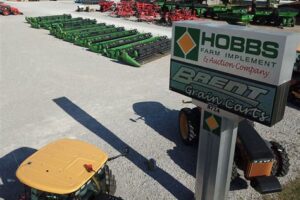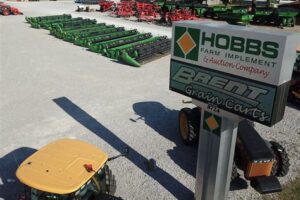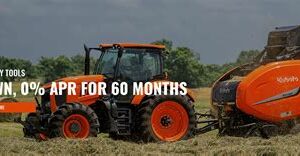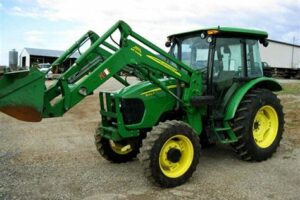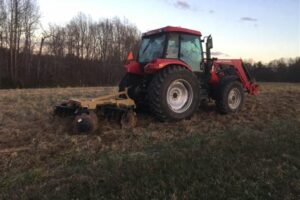Table of Contents
Discover a world of nostalgia with vintage farming equipment. From tractors to harvesters, explore the timeless charm and craftsmanship of these classic machines. Uncover the history of agriculture and witness the evolution of farming technology through the lens of vintage equipment. Whether you’re a collector, enthusiast, or simply curious about the past, step back in time with vintage farming equipment.
Vintage farming equipment, with its timeless appeal and historic charm, transports us back to a bygone era where agriculture was an art form and machinery was built with exquisite craftsmanship. The clanking of metal, the smell of oil and grease, and the sight of weathered wooden handles evoke a sense of nostalgia that is hard to replicate in today’s modern world. As we delve into the intriguing world of vintage farming equipment, we are reminded of the profound impact these tools had on shaping our agricultural history. From hand-cranked seed planters to horse-drawn plows, each piece holds a story waiting to be unraveled, offering a fascinating glimpse into the struggles and triumphs of our farming ancestors. So, let us embark on a journey through time as we explore the wondrous world of vintage farming equipment and uncover the secrets they hold.
The Charm of Vintage Farming Equipment
Vintage farming equipment holds a special place in the hearts of many farmers and collectors alike. These timeless machines, carefully crafted with sturdy materials and innovative designs, provide a fascinating glimpse into the rich history of agriculture. From tractors to plows, each piece tells a story of hard work, resilience, and the evolution of farming practices. In this article, we will explore the allure of vintage farming equipment and its enduring legacy.
Agricultural Revolution: A Walk Through History
When we think of vintage farming equipment, our minds often wander back to a time when agriculture was the backbone of society. The agricultural revolution, which took place from the 18th to the 19th century, brought about significant changes in farming techniques and machinery. This period marked the birth of many iconic pieces of vintage farming equipment that are sought after by collectors today.
Tractors: Powerhouses of the Past
One of the most iconic symbols of vintage farming equipment is the tractor. These powerful machines revolutionized farming by replacing animal labor with mechanized power. Vintage tractors, with their intricate designs and solid construction, evoke a sense of nostalgia among enthusiasts. Each make and model has its own unique features and character, making them highly sought after by collectors.
Plows: Shaping the Land
Plows have been an essential tool in farming for centuries. Vintage plows, often made of durable iron and wood, were meticulously designed to break up soil and prepare it for planting. These antique plows not only showcase the craftsmanship of the era but also provide a window into the challenges faced by early farmers. Collectors cherish these pieces as a testament to the ingenuity of our agricultural ancestors.
Harvesters: Gathering the Fruits of Labor
Before the advent of modern combine harvesters, vintage harvesting equipment played a crucial role in reaping crops. These machines, often operated manually or pulled by horses, required skilled labor and precision. From grain binders to corn pickers, vintage harvesters embody the hard work and dedication of farmers who relied on them to bring in their harvests.
Threshers: Separating Grain from Chaff
Once crops were harvested, threshers came into play to separate the valuable grain from the chaff. Vintage threshers, often powered by steam engines, were marvels of engineering that improved the efficiency of grain processing. These antique machines were not only practical but also played an instrumental role in shaping the way we process and consume food.
Restoration: Preserving the Past
For collectors and enthusiasts, restoring vintage farming equipment is a labor of love. Each piece requires meticulous attention to detail, sourcing of original parts, and often hours of research to ensure authenticity. The restoration process not only breathes new life into these machines but also helps preserve our agricultural heritage for future generations to appreciate and learn from.
Showcasing Vintage Equipment: Agricultural Fairs and Museums
Agricultural fairs and museums play a crucial role in showcasing vintage farming equipment. These venues provide a platform for collectors to display their treasures and educate the public about the history of agriculture. Visitors can marvel at the beauty of restored tractors, plows, harvesters, and threshers while gaining a deeper appreciation for the ingenuity of past generations.
The Legacy of Vintage Farming Equipment
While modern farming equipment has undoubtedly brought immense advancements to the industry, vintage farming equipment should never be forgotten. These machines represent the foundation upon which modern agriculture was built, and they remind us of the importance of innovation, hard work, and sustainability. Their legacy lives on in the hearts of collectors and enthusiasts who continue to celebrate and preserve these timeless marvels of engineering.
Conclusion
Vintage farming equipment holds a special place in our collective memory. From tractors to plows, harvesters to threshers, these machines tell stories of innovation, hard work, and the evolution of agriculture. As we admire and preserve these vintage treasures, we honor the legacy of those who came before us and celebrate the enduring spirit of farming.
Introduction to Vintage Farming Equipment:
Vintage farming equipment refers to machinery, tools, and equipment used in agricultural practices from earlier eras. These artifacts serve as a precious reminder of the rich history and evolution of farming techniques. With their sheer craftsmanship and sturdy design, vintage farming equipment continues to captivate collectors, historians, and farming enthusiasts alike.
Types of Vintage Farming Equipment:
There is a wide range of vintage farming equipment, each serving a specific purpose. From horse-drawn plows and seeders to hand-cranked corn shellers and threshers, these tools symbolize the ingenuity of farmers who relied on manual labor and simple technology to cultivate their land. Milking machines, butter churns, and grain mills are also popular examples of vintage farming equipment that showcase traditional methods of production.
Significance of Vintage Farming Equipment:
Vintage farming equipment holds immense historical and cultural value. These artifacts allow us to gain insights into the lives of farmers from bygone eras, their perseverance, and their ability to adapt to the challenges of the land. They provide a tangible link to our agricultural heritage and highlight the advancements and innovations that have revolutionized farming practices over time.
Preservation and Restoration of Vintage Farming Equipment:
Preserving vintage farming equipment is crucial to maintaining our agricultural history. Organizations, museums, and passionate collectors play a vital role in restoring and conserving these artifacts, ensuring they remain functional and accessible for future generations. Through careful restoration efforts, vintage farming equipment can be brought back to life, allowing us to experience the techniques and manual labor that once dominated farming landscapes.
Collecting Vintage Farming Equipment:
For many enthusiasts, collecting vintage farming equipment is a way to cherish the past and honor the hard work of previous generations. Collectors often seek out specific pieces that hold personal or historical significance, creating impressive displays that showcase the evolution of agricultural practices. The thrill of finding rare or unique items, attending farm equipment auctions, and connecting with other collectors make this a rewarding hobby for those interested in farming history.
Repurposing Vintage Farming Equipment:
While some vintage farming equipment is preserved as historical artifacts, others find new life through creative repurposing. These repurposed pieces can be transformed into captivating decor for homes, restaurants, or farm-themed venues. By repurposing vintage farming equipment, we pay tribute to the ingenuity of our ancestors while giving these items a chance to continue telling their story in a modern setting.
Educational Importance of Vintage Farming Equipment:
Vintage farming equipment serves as a valuable educational tool, allowing us to explore the roots of modern agriculture. Museums, educational institutions, and agricultural programs incorporate these artifacts into their collections to teach students, visitors, and agricultural professionals about the history, mechanics, and significance of early farming practices. Handling vintage equipment firsthand helps individuals grasp the challenges faced by farmers in the past and the innovation that led to present-day agricultural techniques.
Nostalgia and Sentimental Value of Vintage Farming Equipment:
For those with ties to farming families or rural backgrounds, vintage farming equipment holds a deep sentimental value. These artifacts evoke nostalgic memories of childhoods spent on farms, grandparent’s wise words, or a simpler way of life. Displaying or using vintage farming equipment in such cases becomes a way of paying homage to family legacies and preserving cherished memories for future generations.
Vintage farming equipment holds a special place in the world of agriculture. With its timeless design and sturdy construction, it showcases the ingenuity and craftsmanship of a bygone era. Here, we will explore the benefits and significance of using vintage farming equipment in today’s modern agricultural practices.
1. Historical Value:Vintage farming equipment serves as a testament to the rich history of agriculture. It allows us to connect with our farming roots and appreciate the evolution of agricultural practices over time. By preserving and utilizing these pieces of machinery, we pay homage to the hard work and dedication of our ancestors who paved the way for modern farming techniques.
2. Durability and Reliability:One of the most remarkable qualities of vintage farming equipment is its durability. These machines were built to last, with solid metal frames and robust components. Unlike some of their modern counterparts, vintage equipment often requires minimal maintenance and can withstand heavy use without succumbing to wear and tear. This reliability ensures that farmers can continue their operations without interruptions caused by equipment failures.
3. Cost-Effectiveness:Investing in vintage farming equipment can be a cost-effective solution for farmers, especially those with smaller operations or limited budgets. Compared to purchasing brand new machinery, vintage equipment is often more affordable while still delivering excellent performance. Additionally, the simplicity of vintage equipment reduces the need for expensive repairs and complex maintenance procedures, further contributing to its cost-effectiveness.
4. Sustainability:In an era where sustainability is a growing concern, vintage farming equipment offers a greener alternative. These machines were designed to be repaired and reused, reducing the amount of waste generated from constant replacement. By utilizing vintage equipment, farmers contribute to a more environmentally friendly approach to agriculture, minimizing their carbon footprint and promoting a circular economy.
5. Aesthetics and Nostalgia:Beyond their practical benefits, vintage farming equipment adds a touch of nostalgia and charm to agricultural operations. These machines are often beautifully crafted, showcasing intricate details that are seldom seen in modern machinery. The sight of vintage equipment working in the fields evokes a sense of pride and respect for the history of farming, creating a unique ambiance that connects generations and fosters a deep appreciation for the industry.
In conclusion, vintage farming equipment offers numerous advantages for today’s farmers. Its historical value, durability, cost-effectiveness, sustainability, and aesthetic appeal make it a valuable asset in modern agricultural practices. By embracing and utilizing vintage equipment, farmers can honor the past while reaping the benefits of time-tested machinery.
Thank you for visiting our blog and taking the time to learn more about vintage farming equipment. We hope that this article has provided you with valuable insights and information on this fascinating topic. As we conclude, we would like to summarize some of the key points discussed throughout the blog.
First and foremost, vintage farming equipment holds a special place in our agricultural history. These machines were instrumental in revolutionizing farming practices, making them more efficient and productive. From tractors to plows, each piece of equipment played a significant role in shaping the way we cultivate crops and raise livestock. Understanding the evolution of these tools helps us appreciate the advancements we have made in modern farming.
Furthermore, vintage farming equipment not only serves as a reminder of our past but also offers opportunities for preservation and restoration. Many collectors and enthusiasts take great pride in acquiring and maintaining these pieces, ensuring their historical significance is not lost. By restoring vintage equipment, we can showcase its functionality and craftsmanship, allowing future generations to appreciate the ingenuity of those who came before us.
In conclusion, vintage farming equipment represents an integral part of our agricultural heritage. These machines have shaped the way we farm and provide us with a glimpse into the past. Whether you are a collector, enthusiast, or simply curious about the history of farming, exploring vintage equipment can be a truly enriching experience. We encourage you to continue learning and engaging with this topic, as it holds immense value not only for our present but also for our future.
Once again, thank you for joining us on this journey through vintage farming equipment. We hope you found this blog insightful and enjoyable. Stay tuned for more engaging content on agriculture and related topics. And remember, the knowledge we gain from our past helps us cultivate a better future.
Video Vintage Farming Equipment
People also ask about Vintage Farming Equipment:
-
What is vintage farming equipment?
Vintage farming equipment refers to agricultural machinery, tools, and implements that were used in the past but are no longer in production or commonly used today. These items often have historical significance and are sought after by collectors.
-
What are some examples of vintage farming equipment?
Some examples of vintage farming equipment include hand-cranked seed planters, horse-drawn plows, manual hay balers, antique tractors, and threshing machines. These items represent the technology and practices used by farmers in earlier eras.
-
Are vintage farming equipment still functional?
Yes, many vintage farming equipment pieces can still be functional if properly maintained and restored. However, it’s important to note that some machinery may require specific expertise to operate safely and effectively. It is advisable to consult with experts if you intend to use vintage farming equipment for practical purposes.
-
Where can I find vintage farming equipment for sale?
You can find vintage farming equipment for sale in various places. Online auction websites, specialized farm equipment dealers, agricultural museums, and vintage machinery shows are common sources. Additionally, local classified ads, estate sales, and auctions in rural areas may offer opportunities to purchase vintage farming equipment.
-
What should I consider before buying vintage farming equipment?
Before buying vintage farming equipment, it is crucial to assess its condition, availability of spare parts, and the cost of restoration if needed. Understanding the history and value of the equipment, as well as its compatibility with your specific farming needs or collection, is also important. Consulting with experienced collectors or professionals can help you make an informed decision.
Remember that vintage farming equipment requires proper handling and maintenance to preserve its historical value and ensure safe operation. Always prioritize safety when using or displaying these items.

